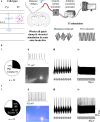Cell-specific effects of temporal interference stimulation on cortical function
- PMID: 39223260
- PMCID: PMC11369164
- DOI: 10.1038/s42003-024-06728-y
Cell-specific effects of temporal interference stimulation on cortical function
Abstract
Temporal interference (TI) stimulation is a popular non-invasive neurostimulation technique that utilizes the following salient neural behavior: pure sinusoid (generated in off-target brain regions) appears to cause no stimulation, whereas modulated sinusoid (generated in target brain regions) does. To understand its effects and mechanisms, we examine responses of different cell types, excitatory pyramidal (Pyr) and inhibitory parvalbumin-expressing (PV) neurons, to pure and modulated sinusoids, in intact network as well as in isolation. In intact network, we present data showing that PV neurons are much less likely than Pyr neurons to exhibit TI stimulation. Remarkably, in isolation, our data shows that almost all Pyr neurons stop exhibiting TI stimulation. We conclude that TI stimulation is largely a network phenomenon. Indeed, PV neurons actively inhibit Pyr neurons in the off-target regions due to pure sinusoids (in off-target regions) generating much higher PV firing rates than modulated sinusoids in the target regions. Additionally, we use computational studies to support and extend our experimental observations.
© 2024. The Author(s).
Conflict of interest statement
The authors declare no competing interests.
Figures





References
Publication types
MeSH terms
Substances
Grants and funding
LinkOut - more resources
Full Text Sources

